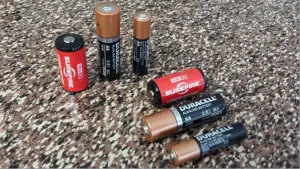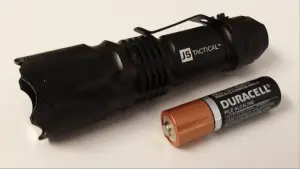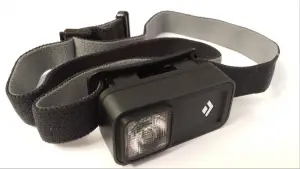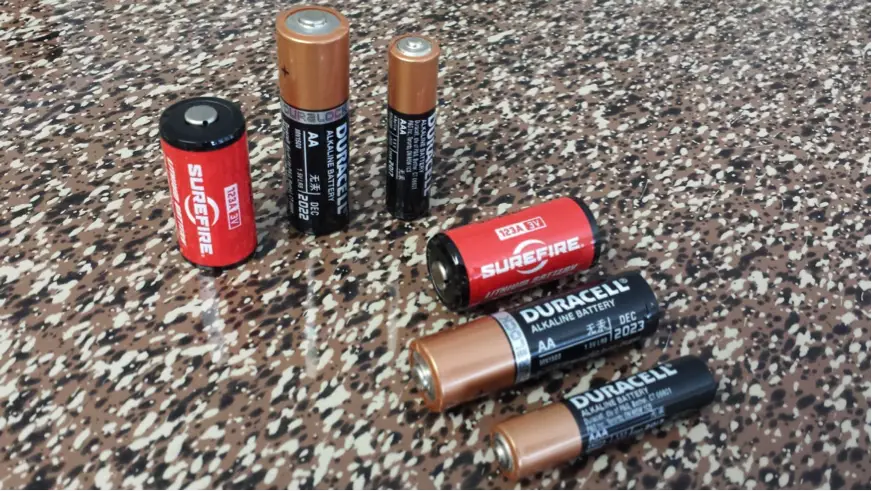
When it comes to survival, the key is having the right mix of gear and skill available to solve a wide array of potential problems that might come up.
As most of us already know, a bug out bag (BOB) is a particular set of gear that is intended to keep you alive for up to 72 hours. Basically it helps you reach your predetermined bug out location (BOL).
For a great refresher on the different type of emergency kits, check out David’s summary.
Before we dive into the battery strategy, I want to share the main assumptions behind a great BOB.
The type of gear that you put in your BOB should be thought around meeting your needs of shelter, water, and food (for energy).
It is important to think about it in that order of priority. On average you can live up to 3 hours in adverse weather, 3 days without water, and 3 weeks without food.
Keep Working on the BOB
Over the years, I’ve spent a lot of time revising my bug out bag in order to get it down in weight so that its mean and lean. My current total BOB weight, including the clothes that I will be wearing, is at 37.3 pounds.
I have found that shelter, including clothes, easily consumes about 33% of the total weight.
Next comes water purification and initial water for the first stretch of the trip, weighing about 20% of the total. Food in terms of energy needs can be had surprisingly light at less than 2 pounds.
The rest of the space, which is about 25%, is reserved for tools, fire making, lighting, health, and miscellaneous other items. It is in these areas where the need for batteries are bound to come up.
Common Batteries Used In BOBs
 Devices that are often found in BOBs include flashlights, lanterns, walkie talkies, weather and emergency radios, or other items based on your own specific needs.
Devices that are often found in BOBs include flashlights, lanterns, walkie talkies, weather and emergency radios, or other items based on your own specific needs.
The main issue here is that electronics tend to be bulky and heavy. On top of that, they require batteries to run, which are also bulky and heavy.
With a BOB, your goal should be weight reduction to the point of meeting the requirements of keeping you alive for 3 days without injury. If you have never carried a backpack that weighs more than 35 pounds, I suggest you try it out before you load your BOB to the brim.
Over the course of 3 days, you will need a flashlight at a bare minimum to operate and navigate in the dark. Depending on other necessities, you might choose more devices to add to your bag. It is recommended that you at least have a handheld flashlight, a headlamp, and a key-chain light.
The most common battery types that you will encounter with these devices include: AAA, AA, 123A, and 18650. We will go over the main details for each of these next.
AAA
The AAA battery is a common size that you can find almost anywhere. For a typical Alkaline version, the voltage is 1.5 Volts, and the energy it contains will last you about 10 hours at 0.1 Amps of current consumption for the average Duracell. The weight is 0.35 ounces per battery.
AA
The AA battery is similarly common like the AAA. The voltage is the same at 1.5 Volts, however the size is bigger, giving it more energy. In contrast, the AA battery can last about 26 hours at 0.1 Amps of current consumption. This is over 2.5 times more than the AAA. The weight of the AA is 0.85 ounces, which is about 2.5 times more than the AAA, naturally.
123A
The 123A is a specialty Lithium type of battery that you find in higher power flashlights. The voltage is 3.0 Volts, which is similar to two AAA/AA stacked together in series. A Duracell 123A can last around 16 hours at 0.1 Amps of current pull. This puts it somewhere in between the AAA and AA. It weighs in at 0.5 ounces.
18650
The 18650 is a rechargeable Lithium battery at 4.2 Volts. These batteries vary in performance by manufacturer quite a bit, but on average you can expect it to last about 20 hours at 0.1 Amps of current pull. The weight is higher at 1.6 ounces. Note that many flashlights these days will come with an option of using either a 18650 or a pod that takes 3 AAA batteries instead.
Best Battery Strategy
 We just looked at four common battery types that you will see most often for these types of electronics. They vary in voltage, current capacity, volume, and weight.
We just looked at four common battery types that you will see most often for these types of electronics. They vary in voltage, current capacity, volume, and weight.
When it comes to thinking about a strategy, one thing to note is that you most likely won’t be using all of your gear at the same time. The core item that may overlap use with other devices is going to be the flashlight if you are using something in the dark.
Otherwise, chances are you won’t be using your walkie talkie while also listening to your emergency radio. If you are using your lantern, you won’t be using your flashlight, and so on.
With this in mind, we can start thinking about the advantages of choosing one specific battery type to go for on our electronics instead of just buying electronics and separate batteries for each device.
The best way for this to work is to select your most important piece of gear first, which is typically the walkie talkies, and then down selecting your other gear to match the same battery type.
For example, there are some very great performing flashlights out there in all of the battery types that we have covered. David posted two awesome flashlights that he was considering for his BOB. It was between the Klarus XT11S (18650 battery) and the Felix LD41 (AA batteries).
Buy a Light Based on Battery First
What I learned is that it might be more strategic to choose a flashlight based on its battery type first, and then based on its other features.
I did a ton of research and put together the top performers in flashlights. From the top 10 AA flashlights, one of the best for your BOB is the J5 Tactical V1 Pro, which runs on a single AA battery.
I bought one, tested it, and found that it can run on high for 4 hours and on low for 20 hours from one battery. That’s pretty amazing. It’s not the brightest flashlight out there, but for the price, weight, light output, and performance, it is hard to beat.
As for the top AAA flashlights, the Streamlight Stylus Pro is a great option and runs on 2 AAA batteries. The run time is about 6 hours.
Obviously, you are going to have the best opportunity to replenish your batteries if you go with either AAA or AA. They are commonly found almost everywhere. That way, if your batteries get run down before you get to your BOL, you have a much better chance of finding replacements.
Gear Experiments
 Let’s do a simple experiment to see what kind of savings we can get by eliminating multiple battery types. We will pretend that we are being sloppy and not paying attention to battery type or caring about weight reduction.
Let’s do a simple experiment to see what kind of savings we can get by eliminating multiple battery types. We will pretend that we are being sloppy and not paying attention to battery type or caring about weight reduction.
A typical set of walkie talkies can take 3 AA batteries for each headset. So we will need 6 AA batteries to use them. That equals about 5 ounces of battery weight. Should we pack a spare set of batteries and double the weight? Let’s do it. There, that’s 10 ounces for 12 AA batteries.
Now let’s grab a 18650 flashlight which adds another 1.6 ounces of battery weight. We also want a headlamp that runs on 3 AAA batteries, which is another 1 ounce. Of course we want spares for these, so here we have about 5 ounces for all of these batteries.
Combine these three battery types together for these devices including spare batteries and we have a whopping 15 ounces of battery weight! That is nearly a pound just for batteries. In BOB land, that kind of weight is insane to add to your pack. If we were using an emergency radio as well, it would be even worse.
Now, what if we instead chose all of our gear to work off of AA batteries? Let’s use the same walkie talkies that require 6 AA batteries to operate. We can also select a single AA flashlight and a single AA headlamp.
The spare set that we have for the walkie talkies, which is 6 AA batteries could also be used as spares to power our flashlight and headlamp. Adding it all up (I count 14 AA batteries total), this scheme gives us a total of 12 ounces of battery weight. That is a savings of 3 ounces (0.2 pounds) by just being smart with our battery plan. It also gives us a much better pool of backup batteries. If you have multiple family members, the savings on spare batteries can really start stacking up.
Conclusion
It’s clear that battery and device selection is one of the best ways to remove wasted weight out of your bug out bag. Ounces count big time. As we discussed, if you blindly choose your electronics and they happen to have different battery types, then you will have some wasted weight in your pack.
The Best Battery Strategy here is to select your most important electronic device first, and ideally select one that runs on AA or AAA batteries, which will give you the best chance to be consistent across your other electronics.
It’s much easier to select flashlights and headlamps in either the AA or AAA battery variety. If you do this well, you have the opportunity to save at least 3 ounces or more as seen from our gear experiment.
If you have already built your BOB, then give your battery plan another look. It just might be a great way to shave off some much needed weight, while offering you a much better pool of backup batteries.
About the Author
Tom Sheppard spends a lot of his free time prepping. He also enjoys camping out in North Texas. With his technical background, Tom does a lot of tinkering with gear. He often shares his knowledge with survival articles at Trek Warrior.
